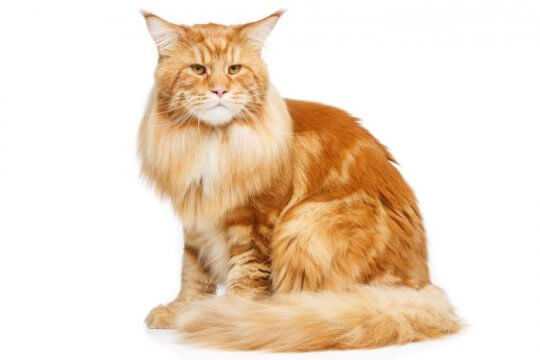Maine Coon

Origin
United States
Height
10"- 16"
Adult Weight
9 to 20 pounds
Life Span
9 to 15 years
TEMPERAMENT
Gregarious, kind, intelligent, family oriented
OTHER NAMES
Maine Cat, Coon Cat, American Coon Cat, Maine Shag, American Forest Cat, Gentle Giant
Group
Large Longhair
Price
$400 to $2,000
Personality and Temperament
Care
- NUTRITION
- GROOMING
- EXERCISE
- HEALTH
Characteristics
History
The Breed Standard
Body
Maine Coon cats are muscular, well proportioned, and rectangular, giving the impression of overall balance. Male Maine Coons are typically larger than females. It's common for a male to achieve a weight of 20 pounds or more.
Head
The medium-width head is a touch longer than it is wide. The medium-length muzzle has a visibly square shape. The chin is strong and firm, and in profile, chin depth appears squared, creating a 90-degree angle.
Eyes
The Maine Coon cat has large, expressive oval-shaped eyes that slant slightly toward the outer base of the ears. The eye color complements the coat’s color.
Ears
The ears are large with wide bases that taper to pointed tips. They are set approximately one ear's width apart at the base, and have ample furnishing. Ear tufts are desirable.
Legs & Paws
The legs are substantial, and of medium length, well proportioned in comparison to the body. The forelegs are straight, and the back legs appear straight when viewed from behind. Maine Coon cats have large, rounded paws that are well-tufted. Polydactyl Maine Coon cats (those with extra toes) are accepted in shows sanctioned by The International Cat Cat Association (TICA).
Tail
The long tail is wider at the base, tapering toward the end. A luxuriant, flowing plume is desirable.
Coat
Maine Coon cats have a heavy and shaggy double coat that consists of an undercoat and longer guard hairs over the top. The coat has a silky texture and falls smoothly. The tail is long and flowing, and a prominent rough on the chest is desirable.
Color
Maine Coon cats come in every color and pattern other than chocolate, lavender, and the Himalayan pattern.
Frequently Asked Questions
-
How much does a Maine Coon cat cost?
How much does a Maine Coon cat cost?Maine Coon cats cost between $400 to $2,000. -
How big do Maine Coon cats get?
How big do Maine Coon cats get?Maine Coon cats tend to be large in size. A fully grown Maine Coon cat might weigh between 9 to 20 pounds or more and range in height anywhere from about 10" to 16" inches tall. -
How long do Maine Coon cats live?
How long do Maine Coon cats live?The Average lifespan for Maine Coon is 9 to 15 years. -
Do Maine Coon cats shed?
Do Maine Coon cats shed?Maine Coon are long-haired cats, so you do have to expect a certain amount of shedding from this breed, but they don't shed as much as other cat breeds.